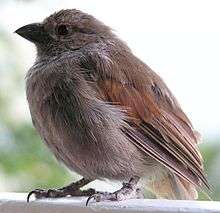Barbados bullfinch
| Barbados bullfinch | |
|---|---|
 | |
| Scientific classification | |
| Kingdom: | Animalia |
| Phylum: | Chordata |
| Class: | Aves |
| Order: | Passeriformes |
| Family: | Thraupidae |
| Genus: | Loxigilla |
| Species: | L. barbadensis |
| Binomial name | |
| Loxigilla barbadensis Cory, 1886 | |
The Barbados bullfinch (Loxigilla barbadensis) is a seedeater bird that is found only on the Caribbean island-nation of Barbados, where it is the only endemic bird species.
Taxonomy
The Barbados bullfinch was previously considered a subspecies of the Lesser Antillean bullfinch (Loxigilla noctis), which is found on neighboring islands.[2] Despite the misleading nature of its name, the Barbados bullfinch is not a bullfinch at all but a seedeater. The bird is known locally as a Sparrow.
Description
The Barbados bullfinch is a small bird, 14–15 cm (5.5–6 in). The upperparts are a dark olive-grey, the wings are mostly brown, underparts are greyish, while the under tail-coverts are tawny. The species is not sexually dimorphic, with females and males having similar plumage. The birds' calls include simple twittering, an occasional harsh petulant note, and a sharp trill .
Distribution and habitat
The Barbados bullfinch is found only on the island of Barbados. The birds' habitat includes shrubbery and forest undergrowth; the species has adapted well to humans, often being found in close proximity to areas of human habitation, such as gardens.
Reproduction
Barbados bullfinches construct a globular nest, with a side entrance, in a tree or shrub. The species lays two to three spotted eggs.
Behavior
Barbados bullfinches are extremely innovative[3][4][5] and tame birds. Barbados bullfinches living in urban environments were found to have better problem-solving skills and a better immunocompetence than the ones living in rural areas of Barbados.[6] As for their temperament, urban Barbados bullfinches were found to be bolder but more neophobic than their rural counterparts.[6]
Gallery
References
- ↑ BirdLife International (2012). "Loxigilla barbadensis". IUCN Red List of Threatened Species. Version 2013.2. International Union for Conservation of Nature.
- ↑ Birdlife International, What's new (2007), archived from the original on 28 August 2007, retrieved 2007-09-05
- ↑ Reader, Simon M.; Nover, Daniel; Lefebvre, Louis (2002-01-01). "Locale-Specific Sugar Packet Opening by Lesser Antillean Bullfinches in Barbados (Individuos de Loxigilla noctis abren paquetes de azúcar en una área localizada de Barbados)". Journal of Field Ornithology. 73 (1): 82–85. doi:10.1648/0273-8570-73.1.82. JSTOR 4131071.
- ↑ Ducatez, S.; Audet, J. N.; Lefebvre, L. (2013-02-14). "Independent appearance of an innovative feeding behaviour in Antillean bullfinches". Animal Cognition. 16 (3): 525–529. doi:10.1007/s10071-013-0612-4. ISSN 1435-9448.
- ↑ Lefebvre, Louis; Ducatez, Simon; Audet, Jean-Nicolas (2016-03-19). "Feeding innovations in a nested phylogeny of Neotropical passerines". Phil. Trans. R. Soc. B. 371 (1690): 20150188. doi:10.1098/rstb.2015.0188. ISSN 0962-8436. PMC 4780530
 . PMID 26926278.
. PMID 26926278. - 1 2 Audet, Jean-Nicolas; Ducatez, Simon; Lefebvre, Louis (2016-03-01). "The town bird and the country bird: problem solving and immunocompetence vary with urbanization". Behavioral Ecology. 27 (2): 637–644. doi:10.1093/beheco/arv201. ISSN 1045-2249.
- "Barbados Bullfinch (Loxigilla barbadensis) - BirdLife species factsheet". birdlife.org. 2012. Retrieved 26 January 2012.
External links
![]() Media related to Loxigilla barbadensis at Wikimedia Commons
Media related to Loxigilla barbadensis at Wikimedia Commons




